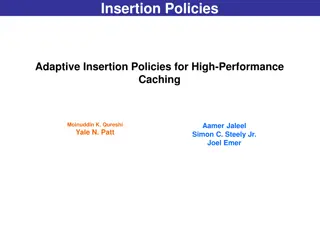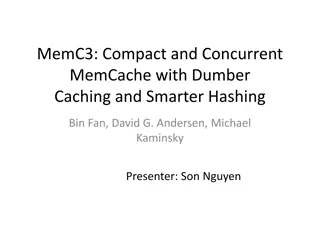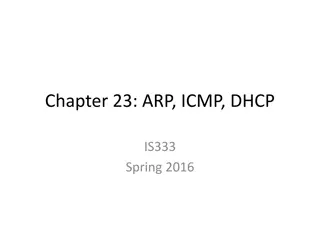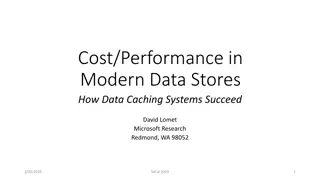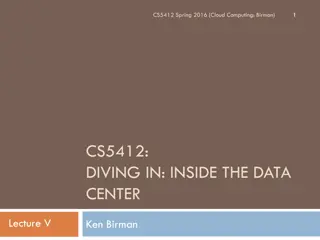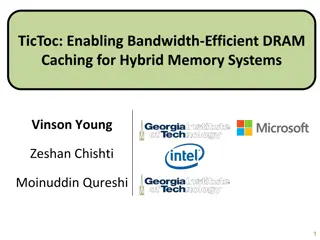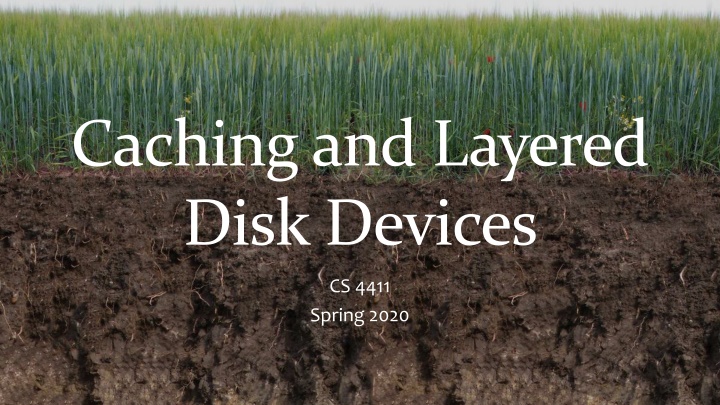
Caching and Disk Devices in Computer Science
Explore the concepts of caching, memory hierarchy, disk blocks, and file system operations in computer science. Learn about the efficiency challenges and solutions in storage systems.
Download Presentation

Please find below an Image/Link to download the presentation.
The content on the website is provided AS IS for your information and personal use only. It may not be sold, licensed, or shared on other websites without obtaining consent from the author. If you encounter any issues during the download, it is possible that the publisher has removed the file from their server.
You are allowed to download the files provided on this website for personal or commercial use, subject to the condition that they are used lawfully. All files are the property of their respective owners.
The content on the website is provided AS IS for your information and personal use only. It may not be sold, licensed, or shared on other websites without obtaining consent from the author.
E N D
Presentation Transcript
Caching and Layered Disk Devices CS 4411 Spring 2020
Announcements EGOS Code Updated Impending Cornell shutdown Next lecture will be conducted via Zoom Office hours will be Zoom meetings hosted by TAs Links will be posted to Piazza
Outline for Today Block Cache Design Memory hierarchy Disk blocks and block cache Write-Through vs. Write-Back The EGOS storage system Block devices Layering Code details
Memory Hierarchy Access Time Size 4 cycles (1 ns) 64 KB L1 Cache 12 cycles (4 ns) 256 KB L2 Cache 42 cycles (14 ns) 9 MB L3 Cache Main Memory 75 ns 16 GB Hard Disk (SSD) 100 ?s 256 GB Hard Disk (Spinning) 10 ms 1 TB
Outline Block Cache Design Memory hierarchy Disk blocks and block cache Write-Through vs. Write-Back The EGOS storage system Block devices Layering Code details
Hard Disk Abstraction Disk drivers provide read/write operations in units of blocks Usually 512 bytes, based on sector size of a spinning disk File system stores files in groups of blocks write(5, 128, &buf) 0 1 2 3 4 5 6 7 8 9 10 11 12 13 14 15 Block #
Operations to Read from a File File System process 1. Read file s inode into memory 2. Get location of data blocks from inode 3. Read each data block in range of read request into memory 4. Respond to file read request 540 541 read(542) foo.txt inode foo.txt inode 542 (1o ms later) block 542 543 read(544) foo.txt data 1 foo.txt data 2 foo.txt data 3 544 foo.txt data 1 read(545) 545 foo.txt data 2 546 547 548 Disk
Operations to Read from a File File System process How long does it take to read 1000 bytes from the file? What happens when we get another read request for the same file? Why is this inefficient? 540 541 read(542) foo.txt inode foo.txt inode 542 (1o ms later) block 542 543 read(544) foo.txt data 1 foo.txt data 2 foo.txt data 3 544 foo.txt data 1 read(545) 545 foo.txt data 2 546 547 548 Disk
The Block Cache Store recently-used disk blocks in memory Cache entry metadata indicates which block it caches (if any) Reading a cached block is a memory access, not a disk access Empty slot 540 metadata Block #, valid 541 foo.txt inode metadata 542 foo.txt inode metadata 543 foo.txt data 1 foo.txt data 2 foo.txt data 3 foo.txt data 1 metadata 544 545 546 Block cache (in memory) 547 548 Disk
Using the Block Cache File System process 540 metadata read(542) 541 foo.txt inode foo.txt inode metadata (14-75 ns later) block 542 542 foo.txt inode metadata 543 read(544) foo.txt data 1 foo.txt data 1 foo.txt data 2 foo.txt data 3 foo.txt data 1 metadata 544 read(545) read(545) foo.txt data 2 545 foo.txt data 2 (1o ms later) block 545 block 545 546 Block cache (in memory) 547 After a cache miss, put the requested block in the cache 548 Disk
Cache Eviction What if the cache is full and a process needs to read a new block? Choose a block to evict based on an eviction algorithm LRU, LFU, CLOCK, etc. Block cache service must keep state for this algorithm This assignment: CLOCK 540 bar.txt inode foo.txt inode metadata 541 bar.txt inode metadata 542 read(548) foo.txt inode metadata bar.txt data 2 543 foo.txt data 1 foo.txt data 2 foo.txt data 3 bar.txt data 1 bar.txt data 2 Disk 544 foo.txt data 1 metadata 545 foo.txt data 2 546 547 Block cache 548
Outline Block Cache Design Memory hierarchy Disk blocks and block cache Write-Through vs. Write-Back The EGOS storage system Block devices Layering Code details
Handling Writes What if a process writes to a block that s in the cache? 540 metadata 541 File System process foo.txt inode metadata 542 foo.txt inode metadata 543 foo.txt data 1 write(544) foo.txt data 1 foo.txt data 2 foo.txt data 3 foo.txt data 1 metadata 544 (1o ms later) Done 545 foo.txt data 2 Opt. 1: Forward the write to the disk now Write-Through cache 546 Block cache 547 548 Disk
Handling Writes Opt. 2: Write to the cache, then sync to disk later 540 metadata Dirty = true 541 File System process foo.txt inode metadata 542 foo.txt inode metadata Sync process: 543 foo.txt data 1 write(544) foo.txt data 1 foo.txt data 2 foo.txt data 3 foo.txt data 1 metadata 544 (1o ms later) Done 545 foo.txt data 2 546 Write-Back cache Mark cache slots as dirty when they need syncing Block cache 547 548 Disk
Outline Block Cache Design Memory hierarchy Disk blocks and block cache Write-Through vs. Write-Back The EGOS storage system Block devices Layering Code details
Storage in EGOS Disk server (disksvr.c) reads and writes blocks to HW Block server (blocksvr.c) also reads and writes blocks Forwards requests to disk server (eventually) Blocks are grouped by inode # File server (bfs.c) stores files in sequences of blocks Each file has an inode for its blocks req: read blocks req: read file user proc Block server BFS read block reply reply Disk server reply: block
Block Service Layering Within the block server, a stack of block stores Each block store has the same interface Block server sends requests to top of stack Each block store knows the block store below it, can pass through read and write operations read(inode, block) Block Server Block data read(inode, block) TreeDisk block store read(inode, block) Block data ClockDisk block store Block data read(inode, block) ProtDisk (relay) block store read(block) (to disk server)
Block Service Layering read(inode, block) This is how EGOS adds a block cache it s a block store layer! Block Server Block data read(inode, block) TreeDisk block store read(inode, block) Block data Reads don t have to be forwarded if the block is in the cache ClockDisk block store Block data read(inode, block) ProtDisk (relay) block store read(block) (to disk server)
Block Service Layering Important: Each block store can have its own interpretation of inode numbers In TreeDisk, inodes track groups of blocks belonging to the same file In ProtDisk, inodes represent disk partitions on the underlying disk server Right now there s only one, so all ProtDisk ops have inode = 0 read(inode, block) Block Server Block data read(inode, block) TreeDisk block store read(inode, block) Block data ClockDisk block store Block data read(inode, block) ProtDisk (relay) block store read(block) (to disk server)
Outline Block Cache Design Memory hierarchy Disk blocks and block cache Write-Through vs. Write-Back The EGOS storage system Block devices Layering Code details
Adding Objects to C A block store is a struct full of function pointers Each FP is a member function whose first argument is this Also a pointer to some other struct containing the block store s state private member variables typedef struct block_store { void *state; int (*getninodes)(struct block_store *this_bs); int (*getsize)(struct block_store *this_bs, unsigned int ino); int (*setsize)(struct block_store *this_bs, unsigned int ino, block_no newsize); int (*read)(struct block_store *this_bs, unsigned int ino, block_no offset, block_t *block); int (*write)(struct block_store *this_bs, unsigned int ino, block_no offset, block_t *block); void (*release)(struct block_store *this_bs); int (*sync)(struct block_store *this_bs, unsigned int ino); } block_store_t; typedef block_store_t *block_if;
Adding Objects to C Each block store class can inherit this interface by providing functions matching the FP types Each can define its own state struct int clockdisk_getninodes(block_store_t *this_bs); int clockdisk_getsize(block_store_t *this_bs, unsigned int ino); int clockdisk_setsize(block_store_t *this_bs, unsigned int ino, block_no newsize); int clockdisk_read(block_store_t *this_bs, unsigned int ino, block_no offset, block_t *block); int clockdisk_write(block_store_t *this_bs, unsigned int ino, block_no offset, block_t *block); void clockdisk_release(block_store_t *this_bs); int clockdisk_sync(block_store_t *this_bs, unsigned int ino); struct clockdisk_state { block_if below; block_t* blocks; block_no nblocks; };
Adding Objects to C Each block store class has a constructor that returns a block_if block_if clockdisk_init(block_if below, block_t *blocks, block_no nblocks) { struct clockdisk_state *cs = new_alloc( struct clockdisk_state); cs->below = below; cs->blocks = blocks; cs->nblocks = nblocks; block_if this_bs = new_alloc(block_store_t); this_bs->state = cs; this_bs->getninodes = clockdisk_getninodes; this_bs->getsize = clockdisk_getsize; this_bs->setsize = clockdisk_setsize; this_bs->read = clockdisk_read; this_bs->write = clockdisk_write; this_bs->release = clockdisk_release; this_bs->sync = clockdisk_sync; return this_bs; } Initialize this object s state Assign the function pointers in block_store_t to this class s implementation of those functions
How Do I Use This? Within a member function, you can safely cast this->state to your own state struct: static int clockdisk_read(block_if this_bs, unsigned int ino, block_no offset, block_t *block) { struct clockdisk_state* cs = this_bs->state; You can call a function on another block store through its block_store_t interface: int r = (*cs->below->read)(cs->below, ino, offset, block); Pass cs->below as the this parameter Call the read function of cs->below
Block Store Functions int getninodes(this): Returns the total number of inodes this block store supports for the disk block store, this will be 1 int getsize(this, inode): Returns the number of blocks associated with the given inode int setsize(this, inode, nblocks): Resizes an inode to include a specified number of blocks; returns the old size. Note that this can implicitly free blocks if the new size is smaller.
Block Store Functions int read(this, inode, offset, *block): Reads a single block at the given offset (in blocks) within an inode, returns it in *block. Returns -1 on error, 0 on success. int write(this, inode, offset, *block): Writes the data in *block to the specified inode and offset (in blocks). Returns -1 on error, 0 on success. int sync(this, inode): Syncs all data within the specified inode to the underlying layer, if this block store is a cache. void release(this): Frees the block store, inverse of init
Your Task for Project 3 Implement a write-through block cache in wtclockdisk.c wtclockdisk_read, wtclockdisk_write, wtclockdisk_setsize Implement a write-back block cache in clockdisk.c clockdisk_read, clockdisk_write, clockdisk_setsize, clockdisk_sync In both files, you ll want to implement this helper function: static void cache_update(struct [wt]clockdisk_state *cs, unsigned int ino, block_no offset, block_t *block [, bool dirty]) Call when you just had a cache miss Use CLOCK to choose a block to evict, put *block in the cache Only clockdisk keeps track of whether blocks are dirty
Keeping Track of Statistics struct clockdisk_state and struct wtclockdisk_state already have some members defined for you, including: read_hit, read_miss: Number of cache hits vs. cache misses for read operations write_hit, write_miss: Number of cache hits vs. cache misses for write operations Update these every time your cache handles a read or write





